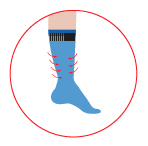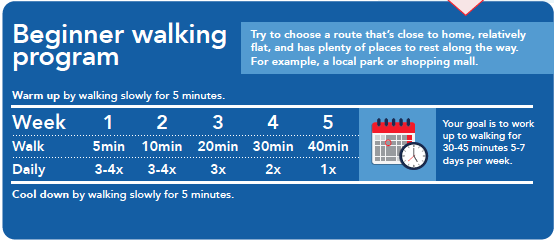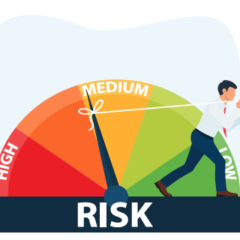Last updated on
Fact vs. Fiction: Exercising After a Blood Clot
Table of Contents
- Staying active to prevent future clots
- But…will I dislodge a blood clot if I exercise?
- Can exercise prevent post-thrombotic syndrome?
- Can I exercise if I’m taking an anticoagulant (blood thinner)?
- Should I wear compression stockings during exercise?
- The bottom line: Exercise is important—and generally safe—after a blood clot
- Beginner-Level Walking Program
Having a blood clot can affect almost every aspect of your life, and one of the most frequently asked questions is: “when is it safe to exercise after my clot?”
While it’s always best to get personalized advice from your own medical team, we can offer some guidance – and bust some persistent myths. Here’s what you should know about returning to exercise after a blood clot.
Staying active to prevent future clots
Immobility is a known risk factor for blood clots, meaning that people who stay still for a long period of time, such as after a surgical procedure or a major injury, are at a higher risk for clots. With that in mind, it’s important to begin increasing the circulation in your legs as soon as you can after you’ve had a blood clot.
However, for many people, returning to exercise after a blood clot may seem challenging or overwhelming. If you’ve had a blood clot in your leg (deep vein thrombosis or DVT), you may be having some residual pain or swelling. If your clot was in your lung (a pulmonary embolism or PE), you may find yourself getting short of breath much more easily than before your clot. In either situation, start where you are – do whatever you can do, even if that’s just a few minutes of slow walking. Over time, as your body recovers from the clot, you’ll likely find that you can do more and build up moderate exercise. (Moderate exercise means that you’re just a little out of breath during the activity – a good rule of thumb is that you can talk but singing would be difficult.)
But…will I dislodge a blood clot if I exercise?
Many people worry that if they exercise after a DVT, a piece of the clot will break off, move to the lungs, and potentially cause a life-threatening PE. This is a persistent myth. In fact, evidence shows that exercising after a blood clot is generally safe. We know that exercise helps prevent future clots, so you shouldn’t feel that you need to avoid exercise due to a fear of dislodging a clot.
Can exercise prevent post-thrombotic syndrome?
Post-thrombotic syndrome, or PTS, is a complication that can occur after a blood clot in the leg. It’s thought to happen when the clot causes a lack of blood flow through the veins in the area. PTS can lead to long-term symptoms even after the blood clot itself is gone; these symptoms may include swelling, pain, changes in skin color, and a feeling of heaviness in the affected limb. Some people with PTS may experience skin wounds that don’t heal.
Some research has shown that exercising after a blood clot helps prevent PTS. There aren’t many studies on exercise and the risk of PTS, but the evidence that we have so far indicates that an exercise program after a blood clot can reduce the risk of PTS. It’s believed that exercise helps to restore blood flow through the area, which in turn reduces the tissue damage that leads to PTS. Another reason to feel more confident about exercising after a clot!
Can I exercise if I’m taking an anticoagulant (blood thinner)?
People can absolutely exercise while on blood thinners. In fact, it’s generally encouraged. If you’re prescribed oral blood thinners or shots, you can start doing moderate exercise within a few hours of your first dose. If you’re on IV anticoagulation, you may need to wait a little longer – about 24 hours.
It is true that you’re at an increased risk for bleeding if you’re on a blood thinner, so you’ll want to carefully weigh what type of exercise to do. The good news is that there are often steps you can take to reduce the risk of falls or injury. For example, you might choose to use hiking poles to help you keep your balance, or ride a stationary bike instead of a regular bike. It is generally recommended that people on blood thinners avoid high-contact activities, like martial arts or skiing, since these activities could cause injuries that result in serious bleeding. Your healthcare team can help you find safer alternatives. If you do fall or sustain an injury while exercising, check in with your doctor as soon as you can.
For anyone on a blood thinner, it’s best to take any type of injury more seriously than you might otherwise. This is especially important if you bumped your head because bleeding in the skull can be extremely dangerous.
Should I wear compression stockings during exercise?
Compression can be very helpful in preventing blood clots. By putting pressure on an area, a compression garment (such as a stocking or sleeve) helps prevent blood from pooling in that area.

Many people choose to wear compression stockings while sitting for long periods, such as on an airplane, during a long car trip, or while at their desk all day, and doing so can reduce the risk of blood clots. Compression can also be helpful during exercise, especially for people who experience discomfort related to the effects of the clot. If you’re having symptoms like pain and swelling while you exercise, consider wearing compression stockings or sleeves to help get some relief.
The bottom line: Exercise is important—and generally safe—after a blood clot
Exercise has huge benefits for your mental and physical health, and after a blood clot, exercise is key to help prevent future clots. Try to incorporate moderate exercise into your life on most days, and make sure that you’re moving around at least once every hour whenever possible. If you’re taking a blood thinner, take extra caution to prevent injuries – but don’t let fear of bleeding stop you from exercising.
Above all, remember to listen to your body and to give yourself some grace. Exhaustion and fatigue are normal symptoms after a clot, so be kind to yourself and rest when you need to. For the first couple of months after your clot, you might not feel like yourself; you might feel like resting is all you can do, and that’s okay because that’s part of the recovery process. Just know that when you’re ready to start exercising again, you can do so safely!
Need help getting started?
See our beginner-level walking program below.
Beginner-Level Walking Program

*Originally published in The Beat — October 2023. Read the full newsletter here.



